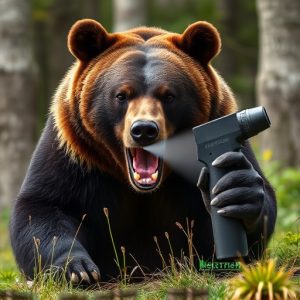Mastering Bear Spray Fog Pattern & Water Safety in Alaska
Understanding the bear spray fog pattern is crucial for water safety in Alaska. Environmental factor…….
Understanding the bear spray fog pattern is crucial for water safety in Alaska. Environmental factors like topography, temperature, humidity, and runoff impact the spray's range and effectiveness. Proper usage techniques, storage, and disposal are vital to prevent off-target misting near waterways, ensuring safe encounters with bears while minimizing harm to ecosystems. Regular testing, expiration checks, and secure storage practices enhance bear spray safety for both users and wildlife.
Alaska’s diverse terrain presents unique challenges when considering bear spray fog patterns. Understanding how bear spray disperses is crucial for effective self-defense. This article delves into the science behind bear spray runoff and water safety considerations, exploring factors that influence its efficacy. From optimal application techniques to best storage practices, we provide insights for Alaskans and visitors alike, ensuring responsible usage in this rugged landscape.
- Understanding Bear Spray Fog Pattern and Its Efficacy
- Factors Influencing Bear Spray Runoff and Dispersion
- Water Safety Considerations When Using Bear Spray
- Best Practices for Effective Use and Storage of Bear Spray in Alaska
Understanding Bear Spray Fog Pattern and Its Efficacy
Understanding the bear spray fog pattern is essential for ensuring water safety during encounters with bears in Alaska. When an individual sprays bear spray, it creates a fine mist or fog that can effectively deter aggressive bears. The fog pattern is designed to coat the bear’s fur, eyes, and respiratory system, temporarily blinding and disorienting it, allowing the person to retreat safely.
The efficacy of bear spray depends on proper usage and understanding of its runoff. Bear spray should be applied in short bursts from a safe distance, typically 20-30 feet away. The mist can travel up to 30 feet, creating a protective zone around the user. However, if not used correctly, the spray can blow back or become diluted with runoff from water sources, reducing its effectiveness. Knowing the fog pattern and its range is crucial for effective bear spray usage in Alaska’s diverse environments, especially near waterways where runoff can occur.
Factors Influencing Bear Spray Runoff and Dispersion
Several factors play a significant role in determining the pattern of bear spray fog, particularly its runoff and dispersion. One key factor is the environment where the spray is deployed. Topography, including terrain elevation and wind patterns, can greatly influence how far and wide the spray reaches. For instance, in rugged terrain with numerous trees and brush, the spray may disperse more slowly and evenly, creating a larger protective zone due to the natural barriers that slow down its movement. In contrast, open plains or areas with little vegetation could lead to faster runoff and longer ranges, requiring users to consider their surroundings carefully when applying bear spray for maximum water safety.
Another crucial element is temperature and humidity levels. Warmer temperatures generally enhance evaporation rates, causing the spray to dissipate more quickly. Conversely, colder conditions can slow down this process, resulting in a denser fog that lingers longer. Humidity also comes into play; higher humidity levels tend to retain the spray’s effectiveness for extended periods, while drier air might cause it to evaporate faster. Understanding these factors is vital for users to anticipate and adjust their application techniques, ensuring they have the best protection possible when facing potential bear encounters in Alaska.
Water Safety Considerations When Using Bear Spray
When using bear spray, especially in aquatic environments like Alaska’s diverse wilderness, understanding water safety considerations is paramount. Bear spray fog can easily be carried by wind and water currents, leading to potential off-target misting. This is particularly relevant near rivers, lakes, or coastal areas where runoff could occur, affecting not only the user but also nearby wildlife and ecosystems.
To mitigate these risks, it’s crucial to apply bear spray responsibly, aiming carefully at the intended target while minimizing wind and water presence. Proper storage and disposal methods are equally important. After use, ensure the spray can is secured and disposed of appropriately to prevent any accidental release into water bodies, maintaining a safe and sustainable environment for both humans and wildlife.
Best Practices for Effective Use and Storage of Bear Spray in Alaska
When using bear spray in Alaska, it’s crucial to follow best practices for optimal effectiveness and safety. Always test the spray before venturing into potential bear country to ensure proper functionality. Check expiration dates regularly, as bear spray can degrade over time. During application, aim for the bear’s face and eyes, creating a dense fog pattern. This method is more effective than aiming for the body, as bears can swat and avoid spray directed at other areas.
Storage is another critical aspect of bear spray safety. Keep the canister in a secure, dry place, away from direct sunlight and extreme temperatures. Never store bear spray near runoff water sources or in areas prone to flooding, as these conditions can compromise the integrity of the container and its contents. Ensure children and pets are unaware of and cannot access the storage location. Regularly inspect for damage or leaks, discarding the canister if any issues are detected.
In conclusion, understanding the fog pattern of bear spray, along with its runoff and dispersion dynamics, is crucial for ensuring water safety while using these devices in Alaska. By considering environmental factors and adhering to best practices for storage and application, individuals can maximize the effectiveness of bear spray as a means of personal protection in bear-inhabited areas. Staying informed about proper usage enhances safety during outdoor activities and helps preserve the well-being of both humans and bears.


